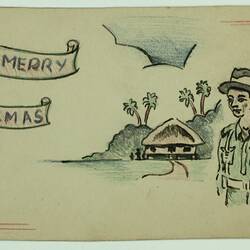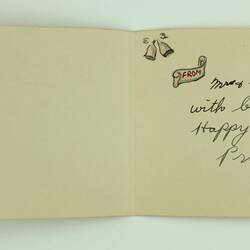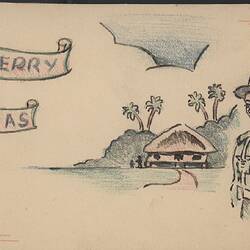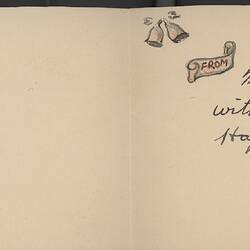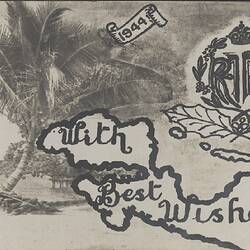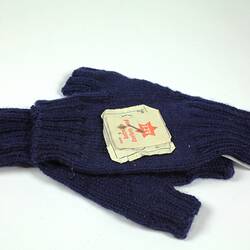Summary
Hand-made Christmas card with drawing of a soldier in a tropical setting on front. The card is from Mr and Mrs I. J Bosel and Son, circa 1943-1945. It is assumed that the card was sent to Margaret Malval as part of a series of correspondence between I.J Bosel and Margaret Malval. The pair began correspondence after Margaret sent Ivan a Christmas package through the Australian Comfort Fund in 1943.
Margaret Malval emigrated to the United States of America from Melbourne, Australia in 1935. During World War II she volunteered for the American Women's Voluntary Services and sent packages to Australian soldiers through the Australian Comforts Fund, thereby entering into an exchange of correspondence with a number of Australian soldiers based in the Pacific and in Australia.
Physical Description
Handmade Christmas card with drawing on front in pencil and ink. The drawing shows a soldier on the right hand side of the card, behind him is a hut and palm trees. 'A Merry Xmas' is written on the left hand side of the card. There is a message inside written in black ink.
Significance
This collection of letters and cards are significant as they illustrate the continuing ties felt by an emigrant to their country of birth. Margaret Malval was born and grew up in Melbourne, Victoria and moved to the United States of America to be married in 1935, where she lived for the rest of her life. Though her husband served in the United States Armed Forces, Margaret chose to send care packages to Australian soldiers through the Australian Comforts Fund, suggesting she retained strong ties to Australia.
These letters and cards were sent from Australian servicemen to Margaret, initially after receiving a care package from her which she donated through the Australian Comforts Fund. These letters and cards highlight the support of people on the home front for Australian servicemen by sending care packages through organisations like the Australian Comforts Fund, and the response of Australian Servicemen on receipt of these packages. Additionally, this collection also helps tell the stories of the frontline experience of Australian servicemen during World War II.
More Information
-
Collecting Areas
-
Acquisition Information
Donation from Ms Jeanne Cook, 05 Nov 2009
-
Sender
-
Addressed To
Mrs Margaret L. Malval, Ridgefield, Connecticut, United States of America, circa 1943 - 1945
Probably sent to Margaret -
Inscriptions
On front of card: 'A MERRY / XMAS.' Inside card: 'FROM / Mr. & Mrs. I.J Bosel. & Son. / with best wishes for a / Happy Christmas and a / Prosperous New Year'
-
Classification
-
Category
-
Discipline
-
Type of item
-
Overall Dimensions - Closed
130 mm (Width), 75 mm (Height)
-
Keywords
Australians at War, Christmas Cards, Correspondence, Military Communication, Military History, War Effort, War Service, Wars & Conflicts, World War II, 1939-1945, Soldiers' Comforts

